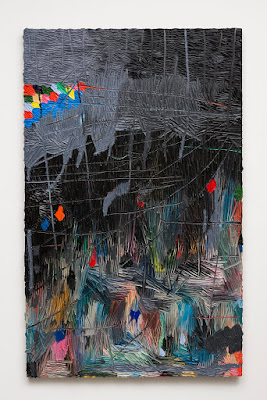
In this body of work, specifically the heads, Kolsrud engages actively in art historical disidentification. By creating so called "double portraits" Kolsrud opts out of tradition, using shaped canvas for figurative work, and by creating psychological portraits of women which transcend the traditional problematics of female portraiture. She recycles the historical trend of shaped canvas, and portraiture, combining them to create portraits of women that exist not for a specifically male gaze, but exist on their own, intelligent terms, rewriting the art historical schema of female portraiture. The "Gates" section of the show, a series of panels hung edge to edge with a repeated gate motif behind which lie peering eyes. This work functions as the viewer, examining you from outside of you, and perhaps even outside of hegemonic culture and its opposition. We can even see this work as a survival strategy of sorts, as women are often objectified by culture the act of creating "double portraits" forces us to consider them in new terms, and the creation of a wall of eyes turns the gaze back onto the viewer, regardless of gender, we see here a reaction against the old hegemony, and a redefinition of the female subject, the viewer, and consequently the artist herself.














































